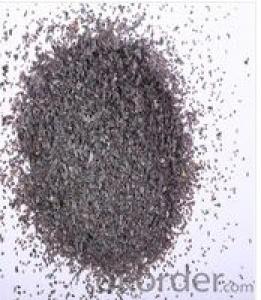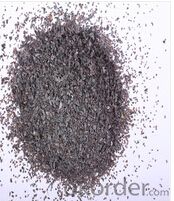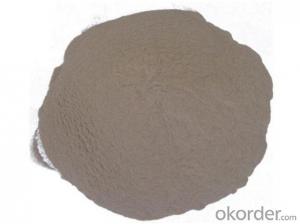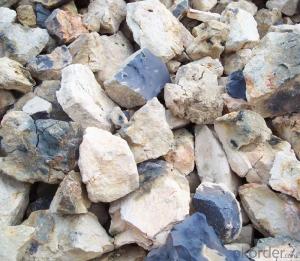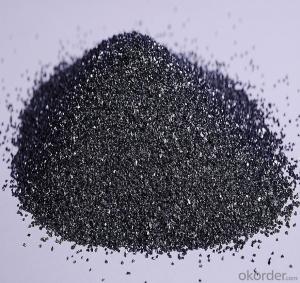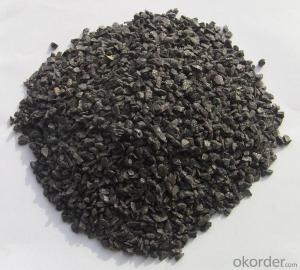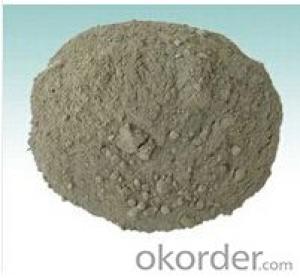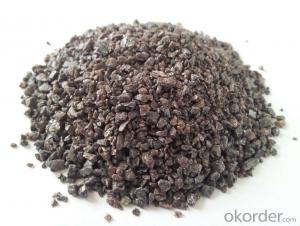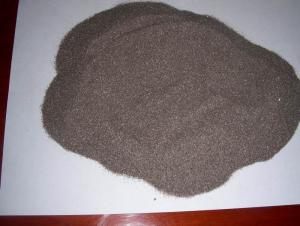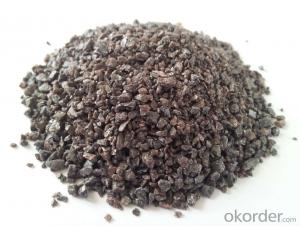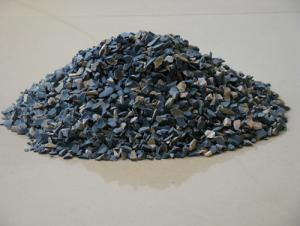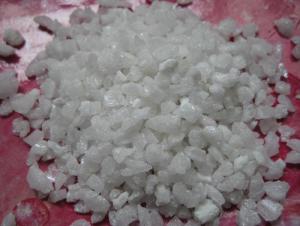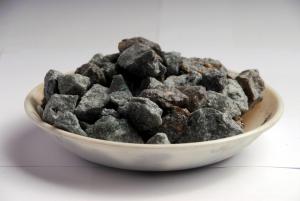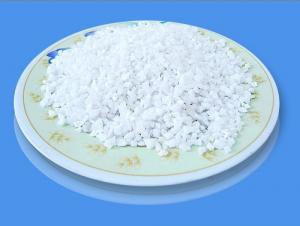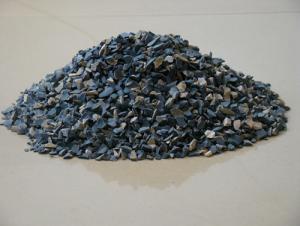Raw Materials for Refractory - Brown Alumina for Refractory Castable
- Loading Port:
- China Main Port
- Payment Terms:
- TT OR LC
- Min Order Qty:
- -
- Supply Capability:
- -
OKorder Service Pledge
OKorder Financial Service
You Might Also Like
Specifications
(1)High Al2O3 Content: 95%min
(2) Professional manufacture
(3) Hot sale overseas
(4) Pass ISO9001:2000.
Brown fused alumina size sand
Product introduction:
The main component of brown fused alumina size sand includes: high quality bauxite, anthracite, scrap iron, its fabrication adopts modern new unique technology. It has short grinding time, high efficiency, good economic returns, low price. Brown fused alumina is superior to other abrasives because it has conchoidal fracture, the edge and corner of this conchoidal are sharp. These edges and corners can form new edge and corner in continuous grinding. The most important characteristics of brown fused alumina are high hardness, high-density,stable chemical
properties and strong self-sharpening. So, it is the best choice for sand blasting process and grinding and polishing, at the same time, brown fused alumina can be used to sandblasting derusting cleaning artifacts and refractory material.
Physicochemical index:
Name | Specification | Chemical compositions(%) | Magnetic material(%) | ||||
Al2O3 | Fe2O3 | SiO2 | TiO2 | ||||
YN-BFA size sand | 0-1mm 1-3mm 3-5mm 5-8mm 8-12mm | ≥95 | ≤0.3 | ≤1.5 | ≤3.0 | — | |
25-0mm 10-0mm 50-0mm 30-0mm | ≥95 | ≤0.3 | ≤1.5 | ≤3.0 | — | ||
Physical property | Chemical property: neutral Refractoriness: 2100 Bulk density: 1.53-1.99g/cm3 True density: 3.95-3.97g/cm3 Mohs hardness: 9.0 | ||||||
1,Grain-size composition: coarse grain ≤5%,fine grain≤5%,basic grain 90% can pass screen mesh or made on the basis of requirements of customer.
25kg,1000kg ,1MT or on the basis of requirements of customer
FACTORY:
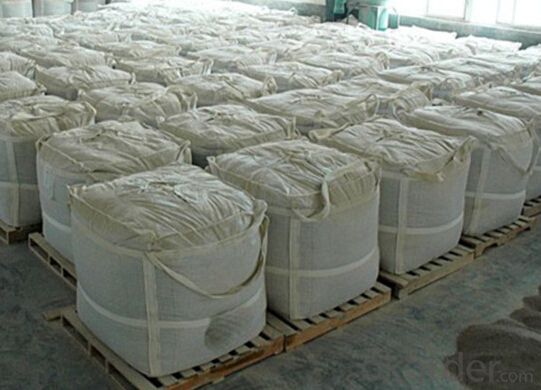
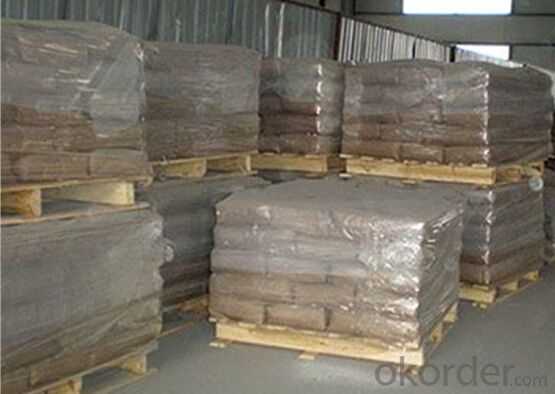
- Q: Does the external wall thermal insulation materials level b1 need the fire barrier zone?
- First, it is prohibited that the thermal insulation material of level B2 and below combustion performance is used in the thermal insulation project of any civil building wall, and the thermal insulation material of below level A combustion performance is used in the thermal insulation project of curtain wall civil builduing that the height is equal and greater than 24m, of non-curtain wall residential building that the height is equal and greater than 100m and of other non-curtain wall civil builduing that the height is is equal and greater than 50m. Civil builduing wall thermal insulation project must strictly enforce the "civil builduing external wall thermal insulation systems and external wall decoration fireproofing interim provisions" (referred to as "fireproofing interim provisions").
- Q: Does anyone know the difference between refractory and thermal insulation material?
- I will give you a relatively simple analysis. Refractory can bear above 1,200 degrees centigrade, but some refractory is not insulated. For example, refractory brick can be directly in contact with heat source, but it has little insulation effect. Refractory includes ceramic fiber, high silica and so on. And they can be also insulated. But insulation effect is not so good as insulation material. Insulation material generally can bear below 800 degrees centigrade, and it is large in thermal resistance, low in heat conductivity coefficient and high in porosity factor, thus reducing heat loss. Briefly speaking, insulated material is to store most heat, and just let a small quantity of heat run of through air, thus insulating heat. Refractory includes glass fiber, rock wool, aerogel blanket and so on.
- Q: Who knows what is the external wall thermal insulation materials for level A fireproofing?
- external wall thermal insulation materials level A fireproofing: Incombustible building material is a material that does not occur any burning. Class A1: Monomer inorganic non-combustible. Noncombustible means no open fire. Class A2: Non-flammable organic compound is namely composite materials and non-flammable, the amount of smoke must be qualified. Class B1: nonflammable building material: non-flame material has good flame resistance. It is difficult to fire under the condition of open fire in the air or high temperature, and it is not easy to quickly spread, and when the combustion?source is removed, the combustion will stop immediately. Class B2: combustible?building?materials: flame material has a good flame resistance. In case of fire in the air or at high temperature, it will immediately burst into flames, and easily lead to the spread of fire, such as wooden column, timber roof truss, timber beam and wooden stairs.
- Q: What is the difference between wear-resistant material and refractory material?
- One is to require wear-resistance. It can be both fire-resistant and wear-resistant, and they can enter different categories. Faced with different demands, it has a variety of features. But both can also be integrated. I think many materials have same division. One is fire-resistant. The two concepts are different division. They are not comparable.
- Q: Using what kind of melting aluminium furnace refractories is more appropriate?
- If it's the ordinary, you can use high aluminum refractory brick with general clay, GB/T 3994-2005 clay heat insulation refractory brick. If you need these with good material, there is high alumina thermal insulation refractory brick, GB/T 3995-2006 high aluminum heat insulation refractory brick, models have A13 and material is the alumina, A13 50 u, high insulating brick B5.Intermediate insulating brick B2, etc. Dolomite brick: good hang kiln performance, good erosion resistance, but brick is usually without f - CaO, hydration, and difficult to transport and storage, less used in the production. Magnesia-chrome bricks: good hang kiln, used in calcining zone. The disadvantage is that its thermal shock resistance is poor and plus hexavalent Cr is toxic, the production and use of magnesite chrome bricks in international countries gradually reduce. Now unit using the brick find replacements as soon as possible.
- Q: What are the raw materials of refractory?
- Refractory is mainly resistant to high temperature and fire. Sic refractories are widely used in refractory. I hope my answer will be helpful to you.
- Q: what is the fireproofing material of engine room? who knows it ?
- 1. The new type fire?retardant?coating in fire retardant coating, the expanded vermiculite, expanded perlite heat insulation material and cenosphere adiabatic powder, etc. These inorganic component, is a major part of the thick coating type of fireproof coating, and they also are the major factor affecting the level of performance of fireproof coatings. The fireproofing thermal insulation properties of fireproof coating, is mainly determined by the fire back surface temperature of this factor, but also related to the fire endurance. If it reaches the same temperature for a longer time, it shows that it's fireproof thermal insulation is better, and the fire endurance therefore is higher. 2. The new fireproof board new fireproof board now is welcomed by the people and the important factor is its environmental protection, and with the increasing high-rise buildings, the fire protection requirements and strength requirements are also rising, it is a big challenge for the performance and standard of the fireproof board.. Now fireproof board is mainly used siliceous material or calcareous materials, and then mixed with the fiber material, lightweight aggregate, adhesives and chemical additives, it is not only be fireproofing, but also improve their thermal insulation performance, and light weight, good carrying capacity, good durability, no aging problem, more importantly, it is good in environmental protection.
- Q: The performance of refractory material
- The mechanical properties of refractory material include withstand voltage strength. The structure properties of the refractory materials include porosity, bulk density, such as thermal emission rate. The physical properties of the refractory materials include temperature conductivity structure performance, wear resistance, hiphotos, electrical conductivity, creep, the hydration resistance, adhesive strength.
- Q: What thickness is needed of the ultra-thin fireproof paint with a fireproof time of 2.5 hours?
- The thickness of steel structure fire retardant coating hasn't been regulated in the steel structure application specification (CECS24:90). The above thickness refers to a certain thickness that must (at least) achieve a certain time of the fire resistance. The thickness of fire-retardant coating in engineering is generally determined according to factory inspection report. We use thin steel structure fire retardant coating: 2.5 hours' fire resistance with the thickness of 4.9 mm; 2.0 hours' fire resistance with the thickness of 3.5 mm; 1.5 hours' fire resistance with the thickness of 1.75 mm; 1.0 hours' fire resistance with thickness of 1.17 mm. I hope I can help you.
- Q: What's the fire resistance test method of doors and roller shutters?
- Fire resistance test method of doors and roller shutters: This standard specifies the fire resistance test method for roller shutter doors under standard fire conditions. The method is used to test the fire resistance of the ventilating duct when bearing the external fire (A duct) and internal fire (B duct). Fire resistance test of vertical ducts may be conducted referring to this standard. 1.Test specimen1.1 The test specimen is obtained by cutting from any part of the qualified metal tube unless otherwise relevant standard or mutual agreement specifies the cutting position of the metal tube. 1.2 Length of the specimen: L≈2.5D+50mm (D: outer diameter of the metal tube). The cut surface of the specimen must be perpendicular to the axis of the metal , and the seamed edge of the cut should be round off. Test method GB243-82 of metal tube necking 2. Test procedures 2.1 In the test, punch or press the metal tube into the tapered conical seat (see Figure) with a hammer or press machine, and make it uniformly diminished to the regulated shrinkage X which is calculated according to the following formula: Test method GB243-822 for metallic pipe necking: The inner wall of the seat cover used in the test should be polished, and has certain hardness and is coated with lubricating oil. Its conicity is 1:10, 1:5 or others in accordance with relevant standard provisions. If there is no provision, then adopt the conicity of 1:10. This standard is not suitable for: a) The pipeline whose fire resistance depends on the fire resistance of the ceiling; b) The pipeline with access door, unless otherwise the access door is included into the pipeline and tested together; c) The pipeline with two or three sides; d) Fume exhaust pipes;
Send your message to us
Raw Materials for Refractory - Brown Alumina for Refractory Castable
- Loading Port:
- China Main Port
- Payment Terms:
- TT OR LC
- Min Order Qty:
- -
- Supply Capability:
- -
OKorder Service Pledge
OKorder Financial Service
Similar products
Hot products
Hot Searches
Related keywords
